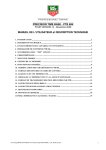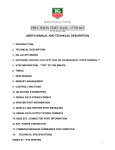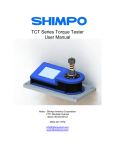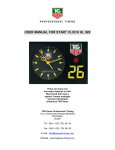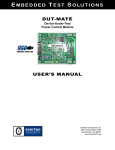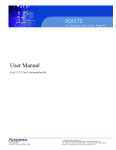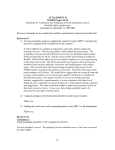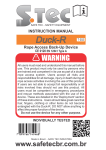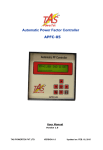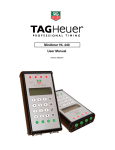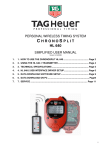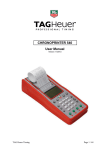Download PRECISION TIME BASE - PTB 606
Transcript
_____________________________ PROFESSIONAL TIMING PRECISION TIME BASE - PTB 606 For PTB version 14 – November 2006 USER’S MANUAL AND TECHNICAL DESCRIPTION 1. INTRODUCTION.............................................................................................................. 2 2. TECHNICAL DESCRIPTION......................................................................................... 3 3. ON and OFF MODES....................................................................................................... 5 4. SOFTWARE CONTROL FOR PTB 606........................................................................ 6 5. SYNCHRONIZATION - “TOP” OF THE MINUTE.................................................... 6 6. TIMING .............................................................................................................................. 7 7. NEW SESSION ................................................................................................................. 7 8. MEMORY MANAGEMENT........................................................................................... 7 9. CONTROL FUNCTIONS ................................................................................................ 8 10. ADJUSTING PARAMETERS....................................................................................... 8 11. SERIAL DATA STRING FORMAT............................................................................. 9 12. PRINTER PORT INFORMATION ............................................................................ 13 13. DISPLAY AND PRINTER PORT MESSAGES........................................................ 14 14. SERIAL DATA OUTPUT STRING FORMATS....................................................... 15 15. DB 25 EXT. CONNECTOR PORT INFORMATION .............................................. 16 16. EXT. POWER CONNECTOR..................................................................................... 16 17. COMMAND MESSAGES SUMMARIES FOR COMPUTER ................................ 17 18.TECHNICAL SPECIFICATIONS................................................................................ 17 Annexe : Printer TAG Heuer « MARTEL » .................................................................... 18 R:\Timing\PRODUITS\PTB606 New\Mode d'emploi\EN\PTB606_v14GB_MARTEL.doc 1 1. INTRODUCTION The PRECISION TIME BASE (PTB) 606 is a compact 16 channel timer that allows for the recording and storage of more than 18,600 times. Controlled by a highly precise laboratory grade thermo-compensated quartz oscillator, the 16 input channels and 3 data output channels (one of them being bi-directional) makes this device the ideal choice for many demanding sports-timing applications in conjunction with PC’s and other downstream systems. The timing th resolution on the printer port is expressed to 1/10,000 / second (.0001) although the PC port allows for full access to th the 1/250,000 / second (0.00001) The PTB can be triggered from zero or from a pre-selectable time-of-day in the 24 hour format. The PTB Timer has 3 RS 232 serial data ports, and can be connected directly to a PC (with bi-directional data communications), to a serial printer, and to an information display board, all simultaneously. Through the use of a connected PC, timing calculations and/or results can be channeled back through the PTB to a printer and a display board, all without using more than one serial (COM) port on the PC- a very practical solution for most laptop systems. The operator can choose to operate the system in ON-LINE or OFF-LINE mode, transferring time data immediately as it is produced or after the timing session is completed. An extensive memory in the PTB stores all times (over 18,600 of them) in a sequential FIFO method with each timing session being assigned a different number. New times generated in a new timing session always start with #1. Up to 128 different timing sessions can be individually stored and recalled. Each PTB has a unit ID number that is engraved on the unit’s chassis and likewise stored in the memory of the device. This ID number is carried on the data stream from the output ports to allow for the use and identification of many separate PTB’s if all connected to a networked PC system. The PTB has minimal hardware controls with all operating parameters adjustable through simple ASCII software commands introduced via the bi-directional RS 232 I/O port. Function keys on the PTB allow for the simple creation of new timing sessions, the clearing of available memory, or to send stored data to a connected printer. Sophisticated power management allows for the use of on-board rechargeable Ni-Cad batteries, or external secondary sources. Power alarms in the form of flashing LED’s and messages on the printer and computer data ports warn of approaching battery exhaustion. In the worst case scenario, the PTB automatically shuts itself off and memorizes all times recorded before the batteries completely fail. TAG Heuer has specifically developed the unique PTB 606 to take full advantage of use with a computerized timing system solution using an attached PC running appropriate timing software. Many specific software systems are available for the PTB, developed either by us or by independent software suppliers for many sports and other applications. Please contact us for a complete list of recent software resources for your PTB 606 or see chapter 4 For the programmers wishing to develop their own applications, we keep at your disposal a file PTB.dll which allows the management of the computer datas sent to the PTB-Printer. Do not hesitate to ask us this file, it will make life much easier for all software programmers! 2 2. TECHNICAL DESCRIPTION The PTB 606 has the following components : On the rear panel: 1. 1x ON-OFF Switch 2. 1x “Banana” jack for synchronization 3. 4x “Banana” jacks for inputs 1 to 4 4. 1x “COMPUTER” 9 Pin Serial RS232 DB-9 connector for data connection to a Computer 5. 1x “ MULTI” 25 Pin DB 25 connector making available all 16 inputs and keypad functions 6. 1x “DISPLAY” 3.5mm jack for Serial RS 232 data output to a display board 7. 1x External POWER and battery charger jack 8. 1x “PRINTER” 9 pin RS 232 Serial data connector for connection to a printer Rear View 3 3 3 3 2 4 8 5 R:\Timing\PRODUITS\PTB606 New\Mode d'emploi\EN\PTB606_v14GB_MARTEL.doc 7 1 6 3 On the top of the PTB 606, a sealed-membrane keyboard featuring: 1. Function Keys: a. b. c. d. SESSION CLEAR MEMORY VALID Creates a new timing session Clears the memory Outputs memory to a computer and/or Printer A safety key - confirms the selection of the preceding keys 2. 4x Green LED’s that serve as indicators for the activation of inputs 1 to 4 3. 4x Keys to manually trigger inputs 1 to 4. 4. 4x Keys to block and unblock external inputs 1 to 4 5. 4x Red LED’s to indicate the blocking status of inputs 1 to 4 6. 1x LED to indicate the status of ON mode and the state of the batteries Green LED = power from batteries, Red LED = External Power View from Above 1d 1a 1c 1d 6 2 5 3 4 4 3 4 3 4 3 4 3. ON and OFF MODES PTB 606 Primary power to the PTB is provided by the internal rechargeable batteries. When the PTB is first turned on, with no external power connected the POWER LED should be green. If it flashes, the rechargeable batteries must be recharged. Whenever an external power supply is connected to the PTB, the POWER LED turns red. It is important to first check the condition of the internal batteries in the PTB using the POWER LED BEFORE connecting the External AC/DC adaptor ! These batteries must be in good state, even if you use the external power supply. When the PTB 606 is switched to the ON position, the following information is printed after the TAG Heuer Logo and likewise sent to the Computer port (example): PTB 606 – V13 No 1234 26.07.04 SESSION 4 MEMORY FREE 12 447 Line 1 indicates the ID Nr of the device( which corresponds to the chassis serial number) and its version Line 2 is the date dd.mm.yy Line 3 indicates the timing session number. When the PTB is switched on, it creates a new timing session in each case. If 3 previous sessions were th resident in the memory, a 4 session is created. Line 4 indicates the number of lines of memory available for new timing data to be recorded. The total capacity of the PTB 606 is 18,687 times (1 time for each memory line). R:\Timing\PRODUITS\PTB606 New\Mode d'emploi\EN\PTB606_v14GB_MARTEL.doc 5 4. SOFTWARE CONTROL FOR PTB 606 The PTB 606 is usually delivered with a software programm allowing the management of sport competitions. This program allows to communicate with the PTB 606 and to enter or modifiy its parameters. You can download the following software programs on the internet homepages www.tagheuer-timing.com or www.soft-control.com : Msports Ski Circuit Jumping Mlap Test F1 Multi-Sports, universal software For the management of ski races (FIS, FFS, FSS,OSV, etc..) For races on circuit (motorsports) For equestrian sports (national and International) For races in circuit, universal software For private tests of motorsports teams (F1, F3, F3000, etc..) SC Excel Freeware allowing to receive the datas of the PTB 606 on an Excel Spreadsheet Each PTB 606 is likewise provided with a computer connection cable. We keep at your disposal a program PTB 606.exe which will allow you to interface with the timer and control all functions from your PC or Laptop even if you do not have application specific software. Do not hesitate to ask us this application in sending an e-mail to [email protected]. 5. SYNCHRONIZATION - “TOP” OF THE MINUTE When the PTB is first turned on, it defaults to its internal Time of Day as taken from the RTC circuit and is immediately ready for synchronization and then subsequent timing operations. Normally, the first input triggering will occur on the synchronization inputs (yellow/black banana jacks) marked SYNCHRO This causes the internal clock of the PTB to begin running from the preset Time of Day (seconds always start from zero) SYNCHRO 13:12:00.0000 th The degree of timing precision (here in this example: 1/10,000 ) on the attached printer is selectable in the set-up parameters of the PTB. After synchronization, the SYNCHRO input jacks become disabled. Only if a new timing session is created is a new synchronization possible. Note that one may select a new timing session and retain the previous session’s synchronization by starting the new session with an impulse received on any of the external inputs 1 to 16. Synchronization is lost when the PTB is turned off (OFF Mode). If it is necessary to record the synchronization signal on any of the other inputs from 1 to 16, one can (as our example here uses input #4 ) connect the input in parallel with the SYNCHRO plugs. On the printer, we would get: SYNCHRO 13:12:00.0000 1 4 13:12:00.0000 Although the PTB uses the date and time-of-day stored in its RTC clock memory as the default synchronization point, it is of course possible to select any time of day, including zero, from which to synchronize the internal clock. To access this feature, the attached computer sends the SET DATE command and the operator then introduces the selected time. A synchronization pulse is required after a new time is selected via the computer to effect the time change. The PTB produces its own very useful synchronization output reference pulse every minute via the 25 pin connector. At the “top” of every minute, pins 22 and 23 output an opto-isolated impulse that can be used to trigger and synchronize other timing devices to the exact time of day as the PTB, or for other timing references or controls Note : Whenever the PTB is turned on, it gets date and time information as permanently managed by its own internal RTC (Real Time Clock) circuit as in most PC’s. This RTC circuit is not however anywhere nearly accurate enough to be used as the time-base for actual timing during the PTB’s operations. No common RTC Circuit is. After synchronization, the PTB uses its own highly precise thermally compensated quartz time-base for actual timing. 6 6. TIMING Triggering impulses arriving at the different inputs of the PTB are all numbered sequentially up from 1 to a maximum of 49,999. All time-of-day times are identified along with the external input channel number on which they were generated, ranging from channel 1 to 16, or with M1 to M4 in the case of manual impulses generated by the keypad buttons. Example of printing output: 2 18 49,999 4 13:12:16.2345 M3 14:01:00.4693 1 23:59:59.9999 Sequential numbering (counting) of times from input channel triggering is increased by one sequential number for each external and each manual impulse received. A manual impulse for channel 3 (M3) will increase the sequential numbering of times counted for input 3 just the same as an external impulse will, and vice-versa. 7. NEW SESSION A new timing session is created by simultaneously pressing the keys VALID and SESSION, or by switching the PTB on. In the first case, the PTB will print: SESSION 5 27.02.99 In the second scenario, the whole initial message is printed: PTB 606 - V13 No 1234 27.02.99 SESSION 5 MEMORY FREE 12,477 When a new session is created, it is possible to synchronize using the SYNCHRO input jacks, or to use the synchronization of the previous session (if the PTB has not been switched off) by triggering any of the timing input channels. 8. MEMORY MANAGEMENT The PTB can memorize up to 18,687 times. Before the memory becomes completely filled, (with 1000 positions still available) the following message is sent: MEMORY FULL If the memory is completely full, one can continue timing without problems, however new times will begin to overwrite the oldest times stored in the memory. Important : The CLEAR function will erase the entire memory (all times and sessions) and create a new timing session No. 1. Once this has happened, a new synchronization can be effected, or the old synchronization can be used immediately When a printer is attached to the PTB 606, one can select to print the amount of available memory still free with a touch of the MEMORY key only (without using the VALID key simultaneously). R:\Timing\PRODUITS\PTB606 New\Mode d'emploi\EN\PTB606_v14GB_MARTEL.doc 7 9. CONTROL FUNCTIONS The PTB monitors the condition of its internal batteries and/or externally connected power supplies as well as the state of an attached printer. It can be powered by 6 alkaline Ni-Mh rechargeable batteries (AA size). When the voltage of the installed batteries gets to the point that either charging or replacement is necessary, an indicator lamp (Green LED POWER) begins to flash and the following message is printed and sent on the PC port: BATTERY LOW Once this message is displayed, the autonomy of the device is now limited to 2 hours at +20 C if internal batteries are only being used. At the point of absolute battery failure, the device automatically shuts down when timing accuracy and subsequent timing data preservation can no longer be assured. Timing data collected to that point is memorized by the device due to another separate memory battery, and the data to that point is not at risk. Likewise the PTB monitors the presence and activity of a connected printer, and sends the following messages to a computer: PRINTER ON or PRINTER OFF These software generated messages are always sent at the beginning of each timing session or during timing if the status at the printer port changes (printer disconnected, printer turned off, or paper out). In these cases, once the printer state is corrected, all data collected and memorized during the interruption of the printer is then sent to the device for printing. 10. ADJUSTING PARAMETERS When connected to a PC, a dialogue between the PTB and the connected PC can be exchanged to manage the selectable parameters of the PTB 606. The default parameters expressed here can be selected/restored at any time by simply pressing the VALID key as the PTB 606 is switched on. This operation (VALID+ON) is necessary to effect when the PTB has not been used for extended periods, or if the computer cannot send messages to the PTB due to some communications conflict (RS232 protocol, speed, parity…). Adjustable parameters of the PTB are by defaults : 8 Date and time Printing Precision Serial port speed Input 1 lock-out time after impulse reception Input 4 lock-out time after impulse reception All other Inputs lock-out time after impulse reception Inputs 5 to 16 blocked DISPLAY ASCII running time 1/100 sec. Buzzer format of DD/MM/YY thousandth/sec. 9,600 baud 1 second 0.5 second 0.5 second No Disabled On 11. SERIAL DATA STRING FORMAT The PTB has minimal keyboard controls and is intended to be controlled mostly from simple ASCII commands received on the COMPUTER connector port (DB9-M) on the rear panel. This COMPUTER port is bi-directional, thus the cable provided allows for data to be received by and transmitted to the PTB on this one PC COM port. Connector DB9 COMPUTER: Pin : 2 3 5 8 Function : Transmit Data (TX) Receive Data (RX) Signal Ground DTR (Data Terminal Ready) Protocol RS232 : 9600 baud, No Parity, 8 data bits, 1 stop bit The ASCII commands listed below allow you to control the functions of the PTB and adjust all parameters. The port is however controlled using the XON/XOFF protocol. The PTB 606 is by default in position XON If the port is not initialized, use ASCII Character #17, CTRL-Q Once initialized, the COMPUTER port will send you timing data and settings information as requested, and allow the PTB to accept further ASCII commands being sent by the connected PC. To close the COMPUTER port, ASCII Character #19, CTRL-S, is used. R:\Timing\PRODUITS\PTB606 New\Mode d'emploi\EN\PTB606_v14GB_MARTEL.doc 9 Data communication protocol of PTB 606 A command from the PC always start with the control character <STX>, and always ends with the control character <ETX>. All commands received and interpreted correctly by the PTB 606 are validated by a control character <ACK> sent from the PTB 606 to the PC. If a command is not understood or contains errors, the PTB 606 will send the control character <NAK> to the PC. When the PTB 606 is in "redirectional" mode (to display or to printer), commands are not interpreted by the PTB 606, except, of course, the command for end of redirection (<LX>). This means that no control character (<ACK> nor <NAK>) exists in "redirectional" mode, except for a <ACK> which validates the end of the commutation. If a command is incomplete or if the <ETX> character has expired, the PTB 606 does not send any control character. To avoid a total blocking (infinite waiting), a "time-out" must be activated on the PC software. There are 33 PC transmittable commands which are divided in 4 categories. There are QUERY commands, PARAMETERS commands, CONTROL commands and LINK commands (for redirection). The following list presents all different command categories and their description. CTRL-Q CRTL-S Opens the PTB COMPUTER port for serial communications (XON) Closes the PTB COMPUTER port (XOFF) QUERY commands QP QM QD PARAMETERS commands PB Pb PE Pe PKxyzz PPx PL Pl PC Pc PNxxxx PDddmmyyhhMM PdmmddyyhhMM 10 query parameters query memory query date buzzer on buzzer off inputs 5 – 16 enable inputs 5 – 16 disable lock time x: 1 channel 1 x: 4 channel 4 x: O other channels y: S time in seconds th y: D time in 1/10 of a second zz: times from 1 to 99 printer accuracy x: 0 second th x: 1 1/10 of a second th x: 2 1/100 of a second th x: 3 1/1'000 of a second th x: 4 1/10'000 of a second th runtime on display is 1/10 of a second runtime on display is disabled serial port speed is 9'600 bds serial port speed is 19'200 bds set serial number of PTB to xxxx set current date to European Format dd: day mm: month yy: year hh: hours MM: minutes set current date to US Format mm: dd: yy: hh: MM: month day year hours minutes CONTROL commands CD CS CU CA CC set all defaults new session upload memory upload memory and print it clear memory LINKS commands LP LL LX link PC to printer link Printer to line unlink PC To add more solidity to the system, a CS (Check Sum) of 1 bit will be added to all command frames, following this format : <STX>xxxx<CS><ETX>. The CS is an addition of all bytes of the command modulo 256. th For example, to give 1/1'000 of a second precision to the printer, the command will be : <STX>PP3<CS><ETX> which gives in hexadecimal code : <0x02><0x50><0x50><0x33><0xD3><0x03> As the PTB 606 is mainly occupied for acquiring timing impulses, it does not have enough resources to treat all different errors and expiry problems provided by a PC. Though, the CRC together with the commands as described hereabove make transfer security very high. Please note that a more accurate computer protocol is available. You may download it from our homepage www.tagheuer-timing.com under section “User Manuals and Protocols” Input “lock-out” time settings. All PTB timing inputs (1 - 16) can be controlled to ignore (lock-out) impulses that arrive at the inputs for specified periods of time after an original impulse is received. This allows you to ensure that only one (1) impulse per competitor is used when each sensor might send multiple impulses during timing line crossing. The adjustment of this lock-out period is crucial to proper time-keeping and varies from sport to sport due to speeds and sizes of the objects present at the timing sensor points (skiers, cars, horses…) Inputs are adjustable in 3 blocks: For Channel 1 using the command PK1… For Channel 4 using the command PK4… For Channels 2,3,5-16 using the command PK0… The selection of which inputs are used for which timing functions should be carefully considered based on the way in which the PTB controls these channel lockout periods. Only channels 1 and 4 can be controlled more extensively and independently from the other remaining channels (2,3,5-16). Thus we recommend that channels 1 and 4 be reserved for use with starts and finishes, and that the other channels be used for intermediate or speed trap sensors. The 3 blocks of timing input channels have 2 possible ranges of lock-out adjustment: 0.1 to 9.9 Seconds using “PKxD” followed by a value 1 to 99 Seconds using “PKxS” followed by a value R:\Timing\PRODUITS\PTB606 New\Mode d'emploi\EN\PTB606_v14GB_MARTEL.doc 11 In addition, two fixed value lock-out times can be selected with the following commands followed by 00 : .01 with the command : No Lock Time with the command : “PKxS00” “PKxD00” Examples: PK1D00 PK1D01 to PK1D99 PK1S00 PK1S01 to PK1S99 Input 1, no lock-out. Input 1 locked out from 0.1 to 9.9 seconds. Input 1 locked-out for 10 milliseconds (0.010) Input 1 locked-out for 1 to 99 seconds For input 4, replace PK1 by PK4 For inputs 2,3 and 5 to 16, PK1 is replaced by PK0 Supplementary Information On receipt of the command QP (request for list of parameters), the PTB in addition sends back to the connected computer an indication on the state of the internal batteries. BATTERY OK BATTERY LOW Battery charge (state) sufficient (OK) Battery charge (state) insufficient, operation time is compromised. As the memory approaches a full state (with space remaining for 1000 times), the PTB sends (on COMPUTER and PRINTER ports): MEMORY FULL 12 12. PRINTER PORT INFORMATION Description: The PRINTER port becomes active and data begins to flow when a Ready State is reached as Pin 8 - DTR (Data Terminal Ready) on the PTB is energized from a hardware handshake (cable connection) to, typically, a printer or other serial computer device. Since the PTB itself does not have a DSR (Data Set Ready) pin on it’s PRINTER port, the PRINTER Port must be controlled by a hardware handshake via an attached serial device. Look for a DSR pin on the printer serial port you wish to attach to the PTB, and connect this to Pin 8 (DTR) on the PTB printer port. Once this hardware handshake is accomplished, all timing data will flow to the printer automatically. You may also send other data that originates from your computer to the PTB and route it to the printer with special commands that are described in the next section of this manual. (LP and LX) The RS232 data being produced by the PTB is then available on Pin 2 of the DB9, with signal ground on Pin 5. Thus, a typical cable to access PTB data via the PRINTER port comprises 3 conductors. The use of stranded, shielded, 22awg cable is recommended. DB9 Port – PRINTER Pin 2 5 8 Function Data Signal (Tx) Signal Ground DTR (Data Terminal Ready) RS232 Protocol : Speed 9600 Bauds, No Parity, 8 data bits, 1 stop bit Note: Set printer to GRAPHICS mode. Important : The printer you use must be able to print in Graphics Mode. If this is not available or disabled, when the PTB tries to print the TAG Heuer Logo at the start of a new session, you will get a long list of random characters instead. If this happens, turn the printer off/on and normal characters will now flow to the printer. The TAG Heuer PTB printer enters Graphics Mode automatically. The advantage of this configuration is that the PTB only sends data when the printer is in a Ready State. Problems like paper out and power difficulties at the printer end cause the port to shut down and data destined for the printer to be held in a buffer memory until the printer problem is corrected. When the Ready State is restored, the printer port reopens and memorized data collected since the port was closed is released and printed. Connexion of the printer PTB PRINTER PORT (DB9 Female) -------------------------------------------------Pin 2 Data Out (Tx) 5 Ground 8 DTR (Data Terminal Ready) PTB-Printer (DB9 Male) -------------------------------------------------Pin 2 Data in 5 Ground 8 Busy R:\Timing\PRODUITS\PTB606 New\Mode d'emploi\EN\PTB606_v14GB_MARTEL.doc 13 13. DISPLAY AND PRINTER PORT MESSAGES The PTB can be asked to accept data being sent from a connected computer and to route it to the dedicated PTB printer port or any attached display panels or other RS232 device via the display port jack. Most importantly, these communications with multiple devices can be managed with only one serial COM port on your PC. This feature is most certainly a major advantage in creating a compact and versatile system since data logging of what the computer is doing with the times being received, or in fact any relevant data such as net time calculations or classified results, can be printed on the PTB’s dedicated printer, thereby eliminating the need for a separate logging printer attached to the computer. It also means that no other COM port on the Computer is needed in order to route information to a display or the printer, a major consideration for most laptop PC owners who are faced with only 1 serial COM port as standard equipment. Data destined for a display or other RS232 device (TV character generator, Announcer Screens) can be sent to the PTB using the sole I/O COM port on your PC, and then routed out back out of the PTB using the 3.5mm RS232 jack provided for this purpose. Note however that all serial data communications on all ports must operate at the same speed of 9600 baud and that this cannot be modified. Any message from the computer can be sent to the PTB in ASCII using the same COM port that accepts the time-ofday data from the PTB since the computer COM port is bi-directional. Protocol speeds must match. Control of what is printed or displayed is simply sent to the PTB in ASCII characters between the following commands : LP Link PC to printer Beginning of message to be printed. LL Link PC to display Beginning of message to be sent to display LX Unlink PC End of message The maximum flow of characters accepted by the PTB-Printer is limited. It is the task of the PC software to manage the quantity of information sent to the PTB-Printer. This application requests from the software programmer to introduce “timeouts” at regular intervals. In order to help you, TAG Heuer puts at your disposal a file PTB_dll which allows an accurate management of these timeouts. Do not hesitate to ask us this file in sending an e-mail to [email protected]. We will send it by email free of charge and you will be able to integrate it in your software program. Running time on the DISPLAY output th The PTB 606 can deliver on the display connector a running time (time-of-day) at a rate of 1/10 of a second. By default this option is not activated. th To activate the running time at a rate of every 10 of a second, use the PL command To inhibit the running time, use the Pl command. 14 14. SERIAL DATA OUTPUT STRING FORMATS Information Type (N,S or T) Unit ID Number 4 Separator (Space) 1 Sequential Number (1 to 49,999) 5 Separator (Space) 1 Input Channel Number 2 Separator (Space) 1 Hours 2 Separator ( : ) 1 Minutes 2 Separator ( : ) 1 Seconds 2 Separator ( . ) 1 1/100000 sec (.999999) 6 End of String (CR) 1 1 ASCII Character(s) N= New Session S= Synchronization T= Timing Data R= Running Time Examples (Serial Data Strings - ASCII,) New Session with Date: 1234567890123456789012345678901 N0000xS002xxxxx28.01.97xPrxOnx(CR) Total=31 characters At Synchronization: 1234567890123456789012345678901 S0000xxxxxxxxxx13:12:00.000000(CR) Total=31 characters During Timing: 1234567890123456789012345678901 Txxxxx00008x04x13:12:16.234567(CR) Txxxxx00003x03x13:12:16.345678(CR) Manual Time, Channel 2: 1234567890123456789012345678901 Txxxxx00001xM2x13:12:16.234567(CR) Total= 31 characters Total=31 characters Serial ASCII Running Time - DISPLAY Output: 1234567890123 Rx12:32:08.4(CR) Total=13 Characters R:\Timing\PRODUITS\PTB606 New\Mode d'emploi\EN\PTB606_v14GB_MARTEL.doc 15 15. DB 25 EXT. CONNECTOR PORT INFORMATION To simplify possibly complex set-up situations, an industry standard DB 25, 25 pin connector is provided on the PTB rear panel to access all inputs and control most functions. Timing Input channels 1 to 4, and the SYNCHRO input channel are available as banana jack connections on the rear panel of the PTB. For applications where access to all of the PTB’s 16 timing Input channels is required, use of the EXT CONNECTOR port is necessary. A DB 25 connector on the rear panel of the PTB 606 provides for access to all of the 16 timing channels as well as the Synchronization port, Special function keys (SESSION, MEMORY, CLEAR), and other outputs like Top-of-Minute triggering and RS232 data as available on the DISPLAY port. Pin 18 is the ground pin for all of the timing and sync. inputs, as well as the SESSION, MEMORY and CLEAR functions. Separate grounds are provided on isolated pins for Top-of-Minute triggering and the RS232 data from the DISPLAY port. Be careful to respect these three different ground functions for the correct operation of your connected devices. Pins 24 and 25 allow you to connect a display board to the DB25 connector rather than via the 3.5mm DISPLAY jack. Access to the SESSION, MEMORY and CLEAR functions as represented on the DB25 connector are made through shorting pins 19, 20 and 21 to pin 18 (ground). Under no circumstances can any voltage be applied to these pins. PIN # 1 2 3 4 5 6 7 8 9 10 11 12 13 14 FUNCTION Timing Channel Input 1 Timing Channel Input 2 Timing Channel Input 3 Timing Channel Input 4 Timing Channel Input 5 Timing Channel Input 6 Timing Channel Input 7 Timing Channel Input 8 Timing Channel Input 9 Timing Channel Input 10 Timing Channel Input 11 Timing Channel Input 12 Timing Channel Input 13 Timing Channel Input 14 PIN # 15 16 17 18 19 20 21 22 23 24 25 FUNCTION Timing Channel Input 15 Timing Channel Input 16 Synchronization Input Timing, Sync and Trigger Ground SESSION MEMORY CLEAR Top of Minute Output + (Isolated) Top of Minute Output - (Isolated) DISPLAY port RS232 Data output, Signal DISPLAY port RS232 Data output, Ground 16. EXT. POWER CONNECTOR Located on the rear panel of the PTB, this 4 pin connector provides the following functions: 1. 2. 3. 4. Ground Not used 12-18 Vdc in (Min. 100ma) Ni-Cad or NI-MH Battery Charging only (9Vdc - 200ma) When connected to pin 3, the PTB draws current from the external Vdc source only, bypassing the internal batteries. If this external power is disconnected or exhausted, the PTB continues operation on internal batteries automatically. View of POWER jack on rear panel 16 17. COMMAND MESSAGES SUMMARIES FOR COMPUTER Commands : Please refer to chapter 11 Messages : BATTERY OK Battery condition OK BATTERY LOW Battery condition compromised - reduced capacity MEMORY FULL At any time during normal operation, when the memory capacity fills up to the extent that only 1000 more times can be memorized before the PTB begins to overwrite the oldest time data in memory this message will be sent to the PRINTER and COMPUTER ports PRINTER ON Whenever a printer is attached to the PTB and the “Ready” mode (DTR Pin 8 on the PTB PRINTER port) is activated, this message will appear. PRINTER OFF Likewise, if the attached printer goes off line, this message will appear PRINTER AND DISPLAY PORT MESSAGES Any message from the computer can be sent to the PTB in ASCII using the same COM port that accepts the TOD data from the PTB. Messages destined for the display or printer attached to the PTB must be enclosed between the following commands: Printer : LP LX Beginning of message to be printed. End of message being printed. Similarly, data destined for a device such as a display board attached to the PTB’s DISPLAY port is sent between the following commands: Display : LL LX Beginning of message to be displayed. End of message being displayed. Consult Chapter 13 for a thorough description of the operation of these commands. 18.TECHNICAL SPECIFICATIONS General High precision Timing Device with 16 channels for up to 128 independent timing sessions. For each session, triggered times are recorded in time-of-day format and numbered in sequential order from 1 to 49,999. Precision 1/250,000th / sec. Internal and available via COMPUTER data port. 1/10,000th / sec. Max. resolution via the PRINTER data port, adjustable from between one second to one ten-thousandth of a second. Inputs 16 Timing Inputs operating in Split mode, identified from 1 to 16 on a DB 25 pin connector. Inputs 1 to 4 are also available on banana jacks with push-button blocking and unblocking control and manual triggering buttons on the keypad. There is one synchronization channel available on the DB 25 or as a banana jack. Outputs 3 RS232 ports, default protocol speed: 9,600 baud, configured as follows: 1- COMPUTER bi-directional serial data port 1- PRINTER port 1- DISPLAY port with available running time in 10ths /second. Communication / Control Recording and display of times accomplished entirely by external devices using appropriate control and timing calculation software. (PC, printer, monitor, etc.) R:\Timing\PRODUITS\PTB606 New\Mode d'emploi\EN\PTB606_v14GB_MARTEL.doc 17 Function Adjustment Protocol All timer functions and parameters are adjustable via the serial COM port of a PC connected to the COMPUTER port of the PTB using simple ASCII instructions. (Setting Time-of-Day, precision of timing on printer tapes, session choice, memory discharge and printing, input delays and blocking, etc.) X-on/X-off flow control. The PTB likewise sends information back to a connected PC. Memory Capacity 18,687 times in up to 128 different timing sessions. Electronic Construction Based on RISC processor. Time Base Thermally compensated quartz crystal at 16 MHz. +/- 1ppm accuracy between 15 to 25°C. +/- 2.5ppm at -30 to +75°C. Temperature Operating Range (Nominal) -20° to +70° Celsius Date/Time Permanent storage and control of date and time by RTC processor, adjustable via PC. Controls By keys (push buttons), via the DB25 pin connector, or ASCII controls via COMPUTER port SESSION + VALID Creates a new timing session CLEAR MEMORY + VALID Clears the Memory MEMORY + VALID Prints or dumps memory to RS232 ports MEMORY (alone) Prints available memory left. Other OFF MODE, saves all recorded time data and operating parameters for up to 3 months Adjustable signaling tone. Direct Printer control and access if attached to PTB. Battery condition monitoring with alarm. “Top-of-Minute” output impulse via opto-coupled connector for external referencing and synchronization of other timing systems. Power Internal: External: RTC : 6 x Ni-Cad or Ni-Mh rechargeable batteries 12 to 18 Volts, DC. Independent battery recharged when PTB is ON. Physical Dimensions 163 x 142 x 45 mm 6.5 x 5.5 x 2 inches Sealed Membrane Keyboard Weight 1,200 gr / 4 Ounces. Annexe : Printer TAG Heuer « MARTEL » Description The TAG Heuer “MARTEL” Printer allows all timing data to be recorded as it is produced or reprinted from the extensive memory of the PTB. For the operations of the TAG Heuer “MARTEL” Printer, please refer to the user’s manual of this printer. Connecting the printer to the PTB 606 Timer Connect the printer to the PTB with the cable delivered with the printer. Attach one of the two 9 pins connector to the plug situated on the right side of the PTB, and the other to the 9 pins connector of the MARTEL printer. Printer Operation Always turn on the printer BEFORE the PTB Now turn on the PTB timer. The following information will be printed (example): PTB 606 – V 13 N° 1234 26.07.04 SESSION 5 MEMORY FREE 12 477 If the printer is activated during a timing session in progress, all data memorized since the start of the session will be printed. 18



















